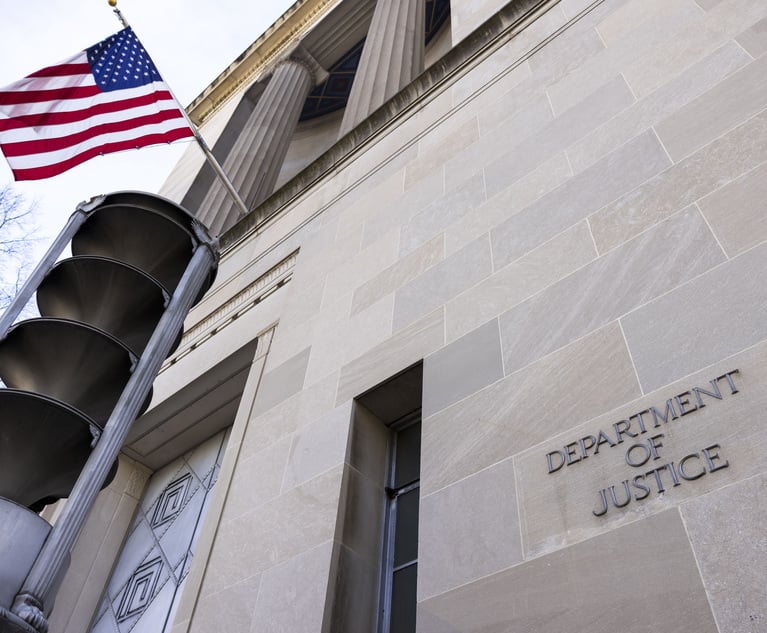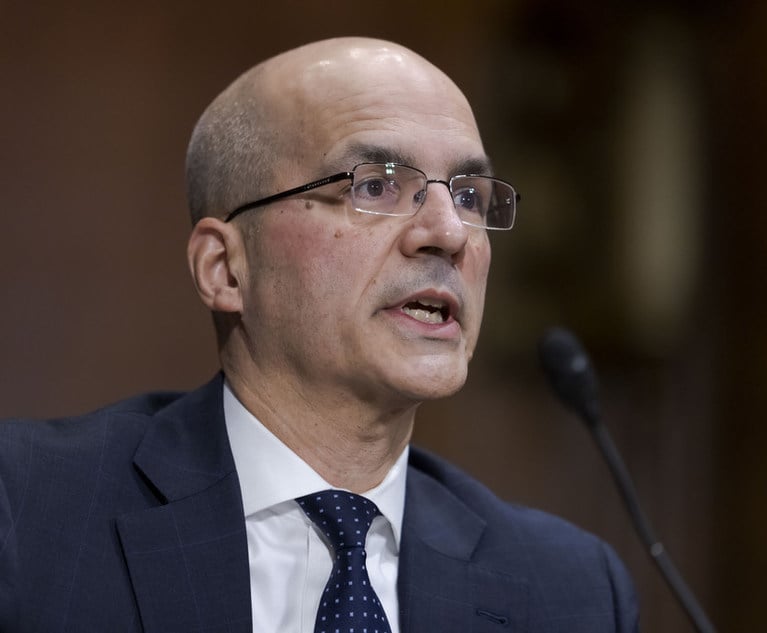Trade Secret Protection Depends on Notifying the Licensee More Than Once
In their Privacy Matters column, Richard Raysman and Peter Brown discuss the decision in 'Broker Genius v. Zalta', in which the U.S. District Court for the Southern District of New York held that the inconspicuous language of the licensor's terms of use, coupled with its routine and frequent disclosure of the entire architecture of the user interface of the software supposedly protectable as a trade secret, precluded licensor's successful motion for injunctive relief for trade secret misappropriation.
February 09, 2018 at 02:50 PM
8 minute read

It is axiomatic that trade secret protection applies only to confidential information. In almost all circumstances, broadcasting to the world the intricate details and applications of a trade secret extinguishes whatever “property right” the holder once possessed. What is a sufficient method of contractually notifying a software user of the trade secret status of certain information is a closer question. According to a recent case from the Southern District of New York, a purported holder of a trade secret cannot omit a confidentiality provision from its terms of use and then claim trade secret status after. Broker Genius v. Zalta, No. 17-cv-2099, 2017 WL 5991831 (S.D.N.Y. Dec. 4, 2017). In Broker Genius, the court held that the inconspicuous language of the licensor's terms of use, coupled with its routine and frequent disclosure of the entire architecture of the user interface of the software supposedly protectable as a trade secret, precluded licensor's successful motion for injunctive relief for trade secret misappropriation.
Facts and Procedural History
Plaintiff Broker Genius created software called AutoPricer v.3 (“AutoPricer”), which assists in the automation for the pricing of tickets in secondary markets. The founder of Broker Genius claimed that he started the company to create software that allowed brokers to build on their existing manual ticket implementation strategies. Broker Genius's innovation was purportedly to allow the implementation of these strategies “within a user interface in which the user could engage with the software dynamically and have the ability to change [his or her] strategy very quickly.”
According to Broker Genius, because such software did not previously exist in the marketplace, Broker Genius expended considerable time and resources on developing AutoPricer, including through honing the user interface through trial and error and customer feedback. As such, Broker Genius created multiple versions of AutoPricer. The third version, released in 2015, was at issue in the instant litigation. In this version, access to the complete software interface and architecture is available to every user. Broker Genius filed a patent application wherein it described the functionality of AutoPricer identically to its description in the case.
Defendant NRZ Entertainment is involved in the ticket broker business. In May 2015, one of defendant's owners signed NRZ up for a 30-day trial of Broker Genius's “full-service” subscription service. On Feb. 3, 2016, Broker Genius and NRZ executed a one-year service agreement granting NRZ full use of the plaintiff's software (the license) which also required NRZ to agree to Broker Genius's terms of use. Throughout the course of the license, Broker Genius employees conducted training sessions and explained to NRZ the capabilities of AutoPricer.
NRZ concurrently began to develop its own automatic ticket pricing software named TickPricer. Although there was no evidence that defendants' accessed the source code of AutoPricer, it is “abundantly clear from the documentary evidence and witness testimony that defendants closely modeled TickPricer on AutoPricer v.3 and relied heavily on their own knowledge of Broker Genius's product to build their own software.” TickPricer became operational in December 2016 and NRZ terminated its license with Broker Genius a month early.
That same month, Broker Genius filed against defendants: (1) a complaint alleging, among other causes of action, violations of trade secret misappropriation under New York law and the Defend Trade Secrets Act (18 U.S.C. §1831 et seq.); and (2) a request under Fed. R. Civ. P. 65 for an ex parte temporary restraining order to, inter alia, seize any of defendants' property containing Broker Genius's trade secrets and restrain defendant from marketing TickPricer.
Legal Analysis and Conclusions
To obtain a preliminary injunction under federal common law, a plaintiff must show: “(1) a likelihood of success on the merits or … sufficiently serious questions going to the merits to make them a fair ground for litigation and a balance of hardships tipping decidedly in the plaintiff's favor; (2) a likelihood of irreparable injury in the absence of an injunction; (3) that the balance of hardships tips in the plaintiff's favor; and (4) that the public interest would not be disserved by the issuance of an injunction.” See Benihana v. Benihana of Tokyo, 784 F.3d 887, 895 (2d Cir. 2015).
The court held that plaintiff was not likely to prevail on its misappropriation of trade secrets claim—the sole claim on which it seeks a preliminary injunction—because the user interface of AutoPricer did not qualify as a trade secret, even though AutoPricer is undoubtedly valuable to Broker Genius and its competitors, and Broker Genius expended roughly $4 million developing the Software.
Courts in New York refer to the Restatement of Torts to formulate a definition of trade secret. See Restatement of Torts §757 (defining a trade secret in relevant part as “any formula … or compilation of information which is used in one's business, and which gives him an opportunity to obtain an advantage over competitors who do not know or use it”). Courts have routinely held that software user and architecture is a protectable trade secret, despite being “inherently broad concept[s].” See, e.g., Integrated Cash Mgmt. Serv. v. Dig Transactions, 920 F.2d 171, 173-74 (2d Cir. 1990) (also holding that a trade secret can exist in a combination of constituent elements, irrespective of whether each element by itself is deemed in the public domain).
Absolute secrecy is not required, but the information claimed to be a trade secret must be shrouded with a “substantial secrecy.” “Reasonable measures” is the lodestar for a trade secret being sufficiently guarded. Of course, the holder can forfeit trade secret protection by making certain disclosures. If a person reveals a trade secret to individuals who are under no obligation to protect its confidentiality, or otherwise publicly discloses the trade secret, “his property right is extinguished.” See Ruckelhaus v. Monsanto Co., 46 U.S. 986, 1002 (1984).
The court concluded that plaintiff had failed to undertake “reasonable measures” to ensure the secrecy of the protectable elements of AutoPricer. The discreet disclosures in Broker Genius's patent application and by its sales representatives in demonstrations, as well as its publication of screenshots of an AutoPricer predecessor software that exposed aspects of AutoPricer, evaluated individually did not extinguish its property rights in AutoPricer. However, “these types of disclosures—especially taken together—do strongly suggest that Broker Genius did not consider AutoPricer v.3's software architecture or user interface to be trade secrets prior to initiating this litigation.” (emphasis in original).
More fatal to plaintiff's claims was its “unfettered access” that it offered to all users. This is the “one disclosure that did destroy Broker Genius's claim that [AutoPricer is] a trade secret.” (emphasis in original). Broker Genius granted each user access to the software itself and technical manuals, as well as sent update emails to explain the operational advantages of AutoPricer's functionalities. Its customer service staff provided answers to user questions centered on elements of AutoPricer that Broker Genius elsewhere claimed were trade secrets. Unfortunately, the avalanche of disclosures about AutoPricer “explains why defendants were able to duplicate major portions of AutoPricer v.3's user interface … with such speed and for relatively low cost[.]”
Broker Genius notified users only in the terms of use that AutoPricer contains trade secrets. The court found this disclosure insufficient. To convey the confidentiality obligations associated with using AutoPricer, the court held that “it would have been reasonable to do something more to notify users of the software's confidentiality.” Broker Genius failed to do so. The terms of use were not accessible through the AutoPricer application, but instead only through its website. The terms of use also “simply does not contain a confidentiality provision.” Most important, the terms of use provision proscribing users from reproducing or distributing AutoPricer did not notify the user of the secrecy of the software, nor that the user was precluded from “describing to others the software's function, structure, and appearance.”
Broker Genius's “widespread and comprehensive disclosures extinguished the trade secret status” of the components of AutoPricer that it claimed NRZ had misappropriated. Accordingly, the court denied plaintiff's motion for a preliminary injunction.
However, on Dec. 20, 2017, the parties agreed to a settlement wherein a permanent injunction was issued against NRZ enjoining it from distributing or selling the TickPricer product. NRZ paid Broker Genius a settlement payment and acknowledged that TickPricer was “improperly derived from [the] AutoPricer software in violation of our contractual obligations with Broker Genius including under Broker Genius' Terms of Use.” The parties dismissed the case with prejudice.
Richard Raysman is a partner at Holland & Knight and Peter Brown is the principal at Peter Brown & Associates. They are co-authors of “Computer Law: Drafting and Negotiating Forms and Agreements” (Law Journal Press).
NOT FOR REPRINT
© 2025 ALM Global, LLC, All Rights Reserved. Request academic re-use from www.copyright.com. All other uses, submit a request to [email protected]. For more information visit Asset & Logo Licensing.
You Might Like
View All
'A Shock to the System’: Some Government Attorneys Are Forced Out, While Others Weigh Job Options
7 minute read
'Serious Legal Errors'?: Rival League May Appeal Following Dismissal of Soccer Antitrust Case
6 minute read
How Some Elite Law Firms Are Growing Equity Partner Ranks Faster Than Others
4 minute read
Trending Stories
- 1States Accuse Trump of Thwarting Court's Funding Restoration Order
- 2Microsoft Becomes Latest Tech Company to Face Claims of Stealing Marketing Commissions From Influencers
- 3Coral Gables Attorney Busted for Stalking Lawyer
- 4Trump's DOJ Delays Releasing Jan. 6 FBI Agents List Under Consent Order
- 5Securities Report Says That 2024 Settlements Passed a Total of $5.2B
Who Got The Work
J. Brugh Lower of Gibbons has entered an appearance for industrial equipment supplier Devco Corporation in a pending trademark infringement lawsuit. The suit, accusing the defendant of selling knock-off Graco products, was filed Dec. 18 in New Jersey District Court by Rivkin Radler on behalf of Graco Inc. and Graco Minnesota. The case, assigned to U.S. District Judge Zahid N. Quraishi, is 3:24-cv-11294, Graco Inc. et al v. Devco Corporation.
Who Got The Work
Rebecca Maller-Stein and Kent A. Yalowitz of Arnold & Porter Kaye Scholer have entered their appearances for Hanaco Venture Capital and its executives, Lior Prosor and David Frankel, in a pending securities lawsuit. The action, filed on Dec. 24 in New York Southern District Court by Zell, Aron & Co. on behalf of Goldeneye Advisors, accuses the defendants of negligently and fraudulently managing the plaintiff's $1 million investment. The case, assigned to U.S. District Judge Vernon S. Broderick, is 1:24-cv-09918, Goldeneye Advisors, LLC v. Hanaco Venture Capital, Ltd. et al.
Who Got The Work
Attorneys from A&O Shearman has stepped in as defense counsel for Toronto-Dominion Bank and other defendants in a pending securities class action. The suit, filed Dec. 11 in New York Southern District Court by Bleichmar Fonti & Auld, accuses the defendants of concealing the bank's 'pervasive' deficiencies in regards to its compliance with the Bank Secrecy Act and the quality of its anti-money laundering controls. The case, assigned to U.S. District Judge Arun Subramanian, is 1:24-cv-09445, Gonzalez v. The Toronto-Dominion Bank et al.
Who Got The Work
Crown Castle International, a Pennsylvania company providing shared communications infrastructure, has turned to Luke D. Wolf of Gordon Rees Scully Mansukhani to fend off a pending breach-of-contract lawsuit. The court action, filed Nov. 25 in Michigan Eastern District Court by Hooper Hathaway PC on behalf of The Town Residences LLC, accuses Crown Castle of failing to transfer approximately $30,000 in utility payments from T-Mobile in breach of a roof-top lease and assignment agreement. The case, assigned to U.S. District Judge Susan K. Declercq, is 2:24-cv-13131, The Town Residences LLC v. T-Mobile US, Inc. et al.
Who Got The Work
Wilfred P. Coronato and Daniel M. Schwartz of McCarter & English have stepped in as defense counsel to Electrolux Home Products Inc. in a pending product liability lawsuit. The court action, filed Nov. 26 in New York Eastern District Court by Poulos Lopiccolo PC and Nagel Rice LLP on behalf of David Stern, alleges that the defendant's refrigerators’ drawers and shelving repeatedly break and fall apart within months after purchase. The case, assigned to U.S. District Judge Joan M. Azrack, is 2:24-cv-08204, Stern v. Electrolux Home Products, Inc.
Featured Firms
Law Offices of Gary Martin Hays & Associates, P.C.
(470) 294-1674
Law Offices of Mark E. Salomone
(857) 444-6468
Smith & Hassler
(713) 739-1250






